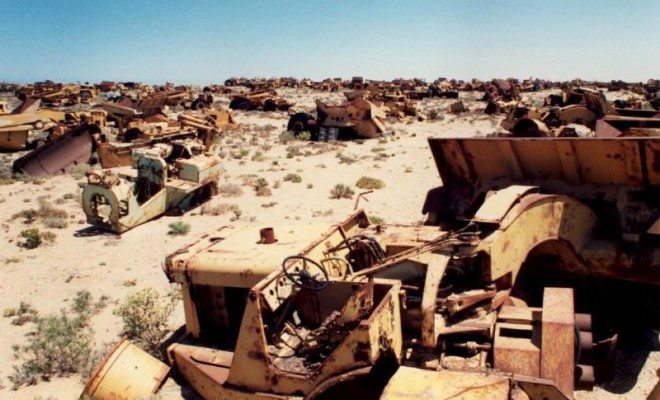 "An extraordinary graveyard, Namibia" courtesy of [sosij via Flickr]
"An extraordinary graveyard, Namibia" courtesy of [sosij via Flickr]
Energy & Environment
The Invisible Burden of Electronics
Human life has become incredibly dependent on electronic technology. The rate of citizens in the developed world who own cell phones, laptops, and other devices have gone sharply up since 2000 and the electronics industry is currently valued at $2.4 trillion worldwide, second in value only to the oil industry. While the proliferation of electronics in our lives have provided new sources of entertainment, increased information access, and made communication easier, the industry also takes an incredible toll on the planet.
Electronics must be built from resources that are generally found underground, which requires high-intensity mining operations. During production, mechanical devices are treated with a variety of toxic chemicals and at the end of their lifetime, electronics are often shipped to developing countries where they become dangerous sources of hazardous waste. However, much of this happens out of sight of the consumer, making the environmental costs of the electronic industry largely invisible to many parts of the world.

Image courtesy of baselactionnetwork via Flickr
An Overview of the Market
Currently, China is the fastest growing player in the electronics industry, because of a combination of its incredibly low labor manufacturing costs and its lack of domestic environmental regulations. Many Asian exporters, Japan and Hong Kong in particular, have steadily shifted large sections of their electronics markets to China as they find themselves unable to compete with China’s low manufacturing costs (labor costs are about 10 percent lower in China than in Hong Kong and overall production cost savings can range between 35 percent to 75 percent depending on the product). Over the years, China has also instituted several supply embargoes on countries that don’t actively participate in trade with Chinese electronic products. The electronics industry continues to grow stronger and stronger in China as the country makes it a more central part of its economy.
Furthermore, the production of electronics is reliant upon 17 rare earth metals (REMs) and access to these metals strongly impacts a country’s ability to grow within the industry. China currently controls between 90 and 95 percent of the planet’s rare earth metals, giving it a huge advantage within the market. Some may misinterpret China’s control over the industry to mean that 90 percent of rare earth metals are found in Chinese land. However, only about one-third of the world’s REMs, most notably dysprosium and neodymium, can actually be mined in mainland China, although the level of mining in China is still incredibly high. What is actually true is that China is responsible for the production of 95 percent of the rare earth metals worldwide; a large portion of Chinese mining and processing happens in the developing world, most notably in Central Africa, which has a number of REMs that can’t be found anywhere else.
Before we delve into the mining process, it should also be noted that while China controls a huge section of the rare earth industry, other countries do have large reserves on their mainlands. This prevents China from having a complete monopoly on the industry and from shouldering all the responsibility when it comes to global pollution. Australia, for instance, controls the vast majority of tantalum, which is crucial for almost every single electronic device.
The Environmental Impacts of Mining
Without rare earth minerals, electronics cannot be produced. However, REMs are buried underground and require high-intensity mining operations for extraction. Mining inevitably creates a huge burden on the local environment, both in terms of groundwater and air pollution. The mineral extraction process generates an incredible amount of waste–80 tons of waste is produced from just one ounce of gold–and much of this waste, including toxic metals, cyanide, and various acids, ends up in the earth and the groundwater of the surrounding area. This can completely contaminate the aquifers where mining takes place, both causing large-scale biodiversity loss and devastating effects on local communities that lose their source of drinking water. The same processes release large amounts of dangerous chemicals into the atmosphere and cause staggeringly high rates of respiratory illness in miners.
Air Pollution from mining isn’t just localized to the immediate area; gold mining, for instance, is a leading source of airborne mercury in the United States after coal-fired power plants. These problems are further compounded by the fact that most mining happens in developing countries where environmental regulations are minimal and poor communities are unlikely to receive government protection.
Rare earth mineral mining is also uniquely hazardous to the environment because it has a more complex extraction process than common minerals do. REMs must be physically removed from the earth, then crushed and milled into dust form. They then undergo a flotation stage to separate the material bastnaesite from the rubble mixture. The isolated mineral bastnaesite is then treated with acids, oxides, and a variety of other solvents to corrode away the common minerals. What is left is the rare earth minerals in their crude form, which must be further purified and then combined into alloys to reach commercial standards.
This 10-day process can be contrasted to gold, which only requires a one-step separation process, to illustrate how complex the process of extraction and production is for rare earth minerals. Due to this added complexity and the nature of the acids used in the refinement, there is a much higher potential for chemical pollution to surrounding areas with REMs as compared to other mineral extractions.
The Social Impacts of Mining
The effects of the mining industry on the environment are significant, but the social influence of the industry has also been highly disruptive. While the majority of Rare Earth Mineral production happens in China, Africa has the largest or second largest reserves of several crucial REMs and other common metals, including bauxite, cobalt, industrial diamonds, manganese, phosphate rock, soda ash, vermiculite, zirconium and several platinum metal groups.
South Africa and Zimbabwe together make up the majority of the world’s platinum metal group deposits and South Africa possesses every single rare earth metal except Bauxite and crude oil, which makes it work well as a trading partner with the Bauxite rich nation of China. However, African countries domestically control a very small share of the profits of these reserves, and the entire continent on average only receives about 15 percent of global exploration, expenditure, and mining investment. The bulk of the industry’s profits goes to foreign mining companies, which have played a role on the continent in some way, shape, or form since the 1800s, although their share has steadily decreased somewhat in the past 20 years. Furthermore, government corruption in many of the mineral-rich African nations has funneled large percentages of the funds from the mining industry away from domestic development, depriving many areas of the supposed benefits of this trade relationship.
In the worst case scenario, the mining industry has helped to fuel conflict in some of the least stable countries in Central Africa. The most serious case of this is in the Democratic Republic of the Congo, where copper, cobalt, and tantalum reserves are controlled and leased to China by a variety of different militia groups. The funds from these mining operations are used by both the government and the rebel forces to finance the weapons and supplies used in the D.R.C.’s ongoing Civil War, which has taken over 5 million lives. While the 2010 Dodd-Frank financial reform legislation strongly dissuaded many mining companies from dealing in “conflict minerals” and financing the warfare, rare earth trade continues to move in and out of the area, especially with China.
Disposal and its Consequences
After extraction, rare earth metals are manufactured into complete products and must be moved over extensive supply chains and across national borders to reach consumers (this has its own burden of CO2 emissions, as does any product involved in international trade). On the other side of extraction is disposal, when the technology is finally thrown away. This happens faster than would be necessary because of product obsolescence, which often involves designing products that break within a few years so a new one must be purchased, and perceived obsolescence, which is a marketing device used to make consumers believe they need newer, better products.
The average life cycle of a cell phone, for instance, is only 18 months. Both product obsolescence and perceived obsolescence are used to fuel the electronics business by ensuring that consumers buy new products regularly, but they cause large shares of electronics to be thrown away every year that could be designed and marketed to have much longer lifetimes.
While all waste comes with an environmental burden, electronic waste, or e-waste, is particularly dangerous to the environment because of its unique components. Rare earth metals themselves can be to the environment, but electronics are also produced with a number of chemicals that are considered extremely hazardous, such as arsenic, lead, mercury, cadmium and polybrominated flame retardants. More than 20 million tons of e-waste are generated each year, with 3.4 million tons coming from the United States alone. Many electronics are difficult to recycle by nature of their design and the chemicals that compose them, which means that more than 60 percent of electronic products have to be disposed of by traditional methods.
E-waste that isn’t recycled and stays in the country where it was purchased, often ending up in landfills where chemicals can leach into local groundwater. Alternatively, e-waste may be burned in incinerators, despite the fact that this releases dioxin, which is one of the most toxic known substances in the world. E-waste that is recycled, however, isn’t generally recycled but rather shipped to developing countries, which will often allow the import of old electronics. Some degree of this is actually recycled and repaired, but huge quantities become pure waste, accumulating in piles that are even less contained than landfills in the developed world. This leads to hazardous chemicals leaching out rapidly and polluting the ground and waterways of the areas they’re dumped in.
The Basel Convention on the Control of Transboundary Movements of Hazardous Waste and Their Disposal was held in 1989 and entered into force in 1992. The primary purpose of the convention to address the mass dumping of waste from the developed to the developing world. The convention declared that any waste that could be categorized as flammable, explosive, poisonous, toxic, ecotoxic, corrosive of infectious must be disposed of as close as possible to where it was used and in the most environmentally friendly manner. In 1995, an amendment was added that banned the shipment of e-waste and other hazardous waste to the developing world for final disposal. However, the amendment did not ban the same shipment as long as the developing country was in agreement and the purpose of the shipment was recycling and not just disposal. Of course, in reality this leaves room for difference of interpretation and many developing countries willingly accept e-waste; what happens after it is dumped is generally difficult for the Basel Convention to track or regulate with any certainty.
Proponents of exporting e-waste to the developing world argue that it’s a beneficial arrangement in that it gives poorer nations access to repairable technology and metal materials. The recycling industry abroad also provides jobs and income for residents, who often live in the poorest parts of the Africa and Asia and depend on the industry for their livelihoods. Foreign exports also provide access to markets for recycled materials that simply don’t exist in developed countries, arguably ensuring that as little e-waste as possible is actually wasted.
However, it’s also true that the recycling processes abroad are incredibly unsafe for the humans who conduct them, which is why developed countries rarely allow such processes to take place domestically. The disposal methods are often crude and dangerous and can involve burning circuit boards to isolate the lead material, burning the plastic off wires in order to access copper, and dissolving heavy metals in acids over fresh water. These operations often take place in residential areas and are performed with little to no safety equipment.

Image courtesy of baselactionnetwork via Flickr
Conclusion
The electronics industry has a significant impact on the environment at several important steps in its life cycle. Resource extraction through mining places a considerable burden on groundwater and the atmosphere, especially because most areas where REM mining takes place have very little environmental regulatory oversight. Furthermore, the mining industry can have negative social impacts on unstable countries where government corruption and internal conflict is high. The problem is compounded by the relevance of the mining industry to the economies of many African countries, which both need the revenue and have the ambition of furthering their national resource control to become key players in the electronics industry themselves.
At the end of the life of an electronic device, its disposal poses yet another danger to the environment because of the number of dangerous chemicals that go into each product. Historically, the bulk of the burden of e-waste is felt in the developing world where the waste is dumped. Dangerous chemicals enter the surrounding environment and the workers charged with disposal expose themselves to terrible health risks. While the Basel Convention has had an important influence on fighting international dumping, it’s still practiced widely and e-waste is still a huge problem globally.
Unfortunately, both the problems of extraction and disposal are largely outside of the view of the consumer, giving the issue little salience among most participants in the electronics industry. As the second most valuable industry on earth, the electronics market is certainly not going to slow down anytime in the near future, until perhaps REMs become a truly scarce resource. Since the environmental burdens of electronics are necessary to increase industry profits and the vast majority of the consumer base does not know or care about these burdens, it’s difficult to say whether or not effective solutions to these will eventually be produced.
Resources
African Compass International: Rare Earth Elements 101
Australian Atlas of Mineral Resources, Mines & Processing Centres: Tantalum
The Economist: Planet of the Phones
Electronics Take Back: Responsible Recycling vs. Global Dumping
Electronics Take Back: Where’s the Harm – From Material Extraction?
Forbes: China’s Rare Earth Monopoly Needn’t put a Electronics Stranglehold on America
Forbes: What 60 Minutes got Wrong about Rare Earths and China
Geology News and Information: REE – Rare Earth Metals and their Uses
IISD: A Brief Introduction to the Basel Convention
I Fix It: The Problem With E-Waste
The National Geographic: Conflict Minerals
Pew Research Center: Mobile Fact Sheet
Pew Research Center: Device Ownership Over Time
Rare Element Resources: Rare Earth Elements
World Health Organization: Electronic Waste
World’s Top Exports: World’s Top Export Products
WTEC: China’s Electronics Industry
World’s Richest Countries: Top Electronics Producers
Yahoo Finance: Consumer Electronics to Reach $289 billion by 2014








Comments